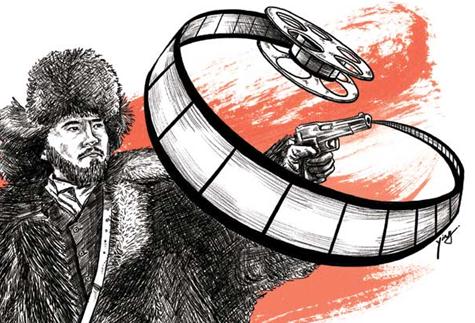

Wang Xiaoying / China Daily
Before Tsui Hark's new film came out at year's end, I, like many critics, was expecting a fiasco. How likely could it be that a filmmaker reared in a freewheeling capitalist system would be able to adapt a "revolutionary" work? The values would clash violently, I presumed.
Surprise, surprise! The Taking of Tiger Mountain turned out to be a runaway hit, not only at the box office, to the tune of 800-plus million yuan (more than $128 million), but by word-of-mouth. The Hong Kong director has accomplished the near impossible-he has brought new relevance to a relic of the "cultural revolution" (1966-76).
To understand what Tsui has done, one has to have a firm grasp of China's cultural scene some 40 years ago. To put it bluntly, there was no culture as most would see it today. Almost all artists were sent into exile or labor camps. The whole population subsisted on only a dozen shows, which were filmed and screened repeatedly across the nation.
There is a lot of misunderstanding about the so-called Eight Model Operas. First of all, they were not born during the "cultural revolution"; most had their first incarnations before 1966. They were handpicked by Jiang Qing (Madame Mao), who essentially served as the producer, or even director, giving specific instructions on every detail, during the metamorphosis into what people later saw en masse. Even Mao himself had a hand in changing the ending of Shajiabang-by supplanting a subterfuge with a direct attack on the enemy. There was also lots of shuffling in casting as renowned performers became the targets of denunciation and were hastily replaced with younger peers.
Suffice it to say, only when the eight shows were filmed-some more than once-was it possible for them to gain a nationwide audience. They were re-adapted for the stage by local performing ensembles, often imitating every move of the screen version. Since they were the staple among a dozen films still permitted for public consumption and received numerous screenings, most people could recite every line.
Second, the Eight Model Operas were not all Peking Operas. Two of them were ballets: The White-Haired Girl and Red Detachment of Women, often shown to foreign visitors as they did not need translation. Not all of them were equally popular. Raid on the White Tiger Regiment, an opera on fighting US soldiers in Korea, was so low on the public radar that another opera, The Azalea Mountain, from a later batch of model operas, was often mistaken for one of the original eight.
Third, these works were never officially banned after the "cultural revolution". The public was so sick and tired of them after a decade of extremely limited entertainment (even the word "entertainment" was frowned upon and the more politically correct "propaganda" was preferred), that they took to the plethora of music choices suddenly available. But one decade later, around the late 1980s, some started to feel nostalgia for the forgotten operas. Arias and scenes reappeared, soon followed by fully staged productions. But only those portraying pre-1949 stories made a comeback because the others run counter to existing government policies, like entrepreneurs being public enemies, as shown in the operas.
Copyright ©1999-2018
Chinanews.com. All rights reserved.
Reproduction in whole or in part without permission is prohibited.